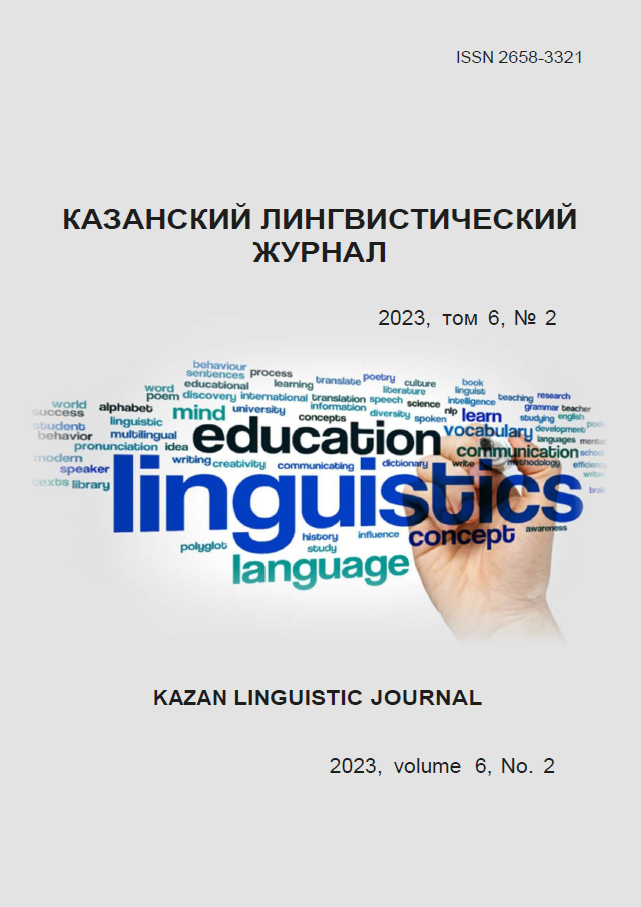To the Problem of Perception and Description of Tembral Voice Characteristics in Children's Game Communication
https://doi.org/10.26907/2658-3321.2023.6.2.271-281
Keywords:
prosody, timbre, children's speech, emotion, psycholinguistic experimentAbstract
The article reflects the results of a psycholinguistic study of the perception of prosodic timbre based on the material of spontaneous children's speech. The problem of describing of the timbre is not sufficiently developed: on the one hand, there is no single interpretation of the concept of «timbre», on the other hand, the question of relating the timbre to the components of intonation still remains unresolved. It is obvious that timbre is a means of conveying the emotive meanings of an utterance, and its perception is based on emotional and evaluative sensations. The article deals with the prosodic timbre, which, unlike the speaker's voice quality, is not a constitutive means. The study was conducted on the material of spontaneous speech of preschoolers in a game. An analysis of the peculiarities of the perception of timbre by «naive» native Russian speakers and phonetic experts showed that the palette of timbres provided to the auditors before the start of the experiment and including only «light» characteristics facilitates the classification of fragments but does not fully reflect the features of speech sounding. The article also compares the results obtained from phonetic experts on the characteristics of the prosodic timbre with the theory of vowel timbres by E.N. Vinarskaya.
References
References
Gorelov I.N. Correlation of verbal and non-verbal in communicative activity. The study of speech thinking in psycholinguistics. resp. ed. E.F. Tarasov. M.: Nauka; 1985. p. 116–150. (In Russ.)
Stumpf C. Tonpsychologie. Band II. Leipzig: Verlag von S. Hirzel; 1890. 614 S. (In Ger.)
Teplov B.M. Psychology of musical abilities. Moscow-Leningrad: publishing house of the Academy of Pedagogical Sciences of the RSFSR; 1947. 335 p. (In Russ.)
Akhmanova O.S. Dictionary of linguistic terms. Moscow: Soviet Encyclopedia; 1966. 608 p. (In Russ.)
Tseplitis L.K. Analysis of speech intonation. Riga: Zinatne; 1974. 272 p. (In Russ.)
Svetozarova N.D. The intonation system of the Russian language. Leningrad: publishing house of the Leningrad University; 1982. 174 p. (In Russ.)
Mullagayanova G.S. Positive emotions explicated in Russian. Kazan Linguistic Journal. 2020;3(1):28–40. (In Russ.)
Vinarskaya E.N. Expressive means of the text (on the material of Russian poetry). Voronezh: Voronezh State University; 2003. 172 p. (In Russ.)
Labov W. Das Studium der Sprache im sozialen Kontext // Aspekte der Soziolinguistik. W. Klein, D. Wunderlich (Hg.). Frankfurt: Athenäum-Fischer-Taschenbuch-Verlag; 1972. S. 123–206. (In Ger.)
Selting M., Auer P., Barth-Weingarten D. et al. Gesprächsanalytisches Transkrip-tionssystem 2 (GAT 2). Gesprächsforschung – Online-Zeitschrift zur verbalen Interaktion. 2022;(10):353–402. URL: http://www.gespraechsforschung-ozs.de/heft2009/px-gat2.pdf [accessed: 17.12.2022]. (In Ger.)
Pospelova S.N. Prosodic features of speech in play communication of preschoolers. dis. candidate of philological sciences. Voronezh; 2021. 145 p. (In Russ.)
Velichkova L.V., Abakumova O.V., Petrochenko E.V., Voropaeva I.V. Project "Psycholinguistic Study of Sounding Speech" . Issues of Psycholinguistics. 2017;(33):240–255. (In Russ.)
Bose I. doch da sin ja’ nur muster.Kindlicher Sprechausdruck im sozialen Rollenspiel. Frankfurt a. M.: Peter Lang; 2003. 438 S. (In Ger.)






